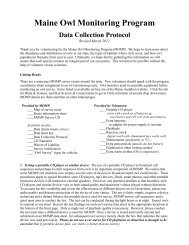Focus Species Forestry - Maine Audubon
Focus Species Forestry - Maine Audubon
Focus Species Forestry - Maine Audubon
You also want an ePaper? Increase the reach of your titles
YUMPU automatically turns print PDFs into web optimized ePapers that Google loves.
Oak-Pine<br />
____________________________________________<br />
Overview<br />
Single-tree and<br />
Group Selection<br />
Shelterwood,<br />
Small Patch<br />
Cuts, and<br />
Clearcuts<br />
Other<br />
<strong>Focus</strong> <strong>Species</strong> Management<br />
Obtaining adequate regeneration in oak-pine forests usually requires some form of<br />
shelterwood management or group-selection harvesting. In the case of white pine,<br />
timing harvests to coincide with an abundant seed year is recommended, while<br />
maintaining partial shade through the sapling phase is important to minimize weevil<br />
damage. In mixed oak-pine stands, white pine regenerates well, due in part to the light<br />
shade offered by oak canopies and perhaps the digging action of gray squirrels. On<br />
moist and rich soils, where red maple and hemlock tend to be more aggressive,<br />
maintaining pine or oak dominance may be impossible.<br />
Light single-tree selection is unlikely to maintain oak-pine except on very dry sites.<br />
Crop-tree management (see Appendix 3) focusing on the best trees combined<br />
with group selection may be used to maintain mature forest conditions. Locate<br />
groups where there are patches of advanced regeneration. Large groups will<br />
provide small patches of early successional habitat.<br />
The shelterwood system is probably the best method for regenerating and<br />
cultivating oak-pine. A regeneration harvest should occur approximately 30 years<br />
before crop trees are expected to mature. When regeneration is established,<br />
maintain the overstory below 40% crown cover to discourage shade-tolerant<br />
competitors but provide enough shade to limit pine weevil damage. A heavy<br />
shelterwood cut will also provide habitat for early successional species.<br />
Patch cuts (2-5 acres) and occasional small clearcuts will provide ideal nesting<br />
habitat for young-forest birds and browse for hare, rabbits, and deer. Low-value<br />
stands may be a good opportunity to use this approach.<br />
Maintain and encourage oak mast trees for bear, deer, turkey, squirrels, and mice.<br />
Follow recommendations for snags, cavity trees, and downed woody material and<br />
other stand-level guidelines (Section 7).<br />
Refer to landscape-level guidelines (Section 8).<br />
Mature hemlock is often indicative of sites that were not cleared for crops or<br />
permanent pasture. These sites add plant and wildlife diversity to the forest and<br />
should be maintained in a mixed-species composition if possible.<br />
References: DeGraaf et al. 1992, DeGraaf and Yamasaki 2001, Flatebo et al. 1999, Lancaster et al. 1978,<br />
Sampson et al. 1983, Seymour 1994<br />
<strong>Focus</strong> <strong>Species</strong> <strong>Forestry</strong> 23



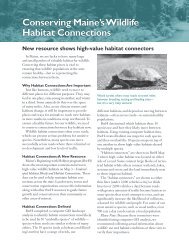
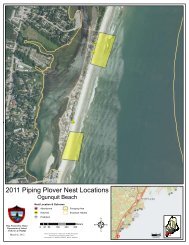

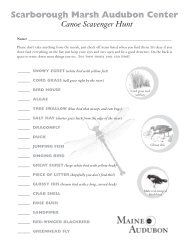


![2012 Loon Count Results [pdf] - Maine Audubon](https://img.yumpu.com/26228732/1/190x245/2012-loon-count-results-pdf-maine-audubon.jpg?quality=85)
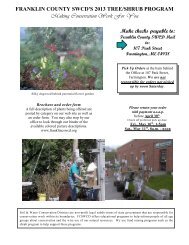
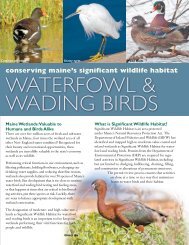
![Lake Fish of Maine (DIFW list) [pdf] - Maine Audubon](https://img.yumpu.com/23282964/1/190x245/lake-fish-of-maine-difw-list-pdf-maine-audubon.jpg?quality=85)
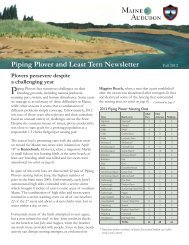

![The Maine Audubon Peony Circle of Friends 2012 [pdf]](https://img.yumpu.com/22707677/1/190x253/the-maine-audubon-peony-circle-of-friends-2012-pdf.jpg?quality=85)
